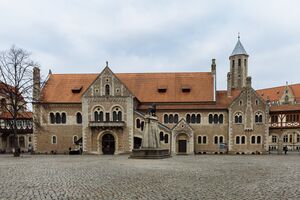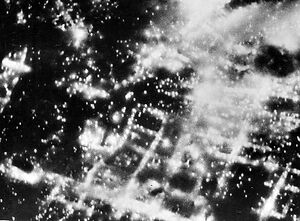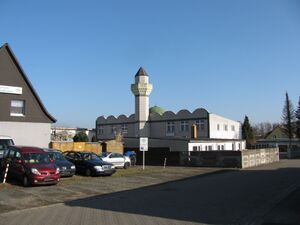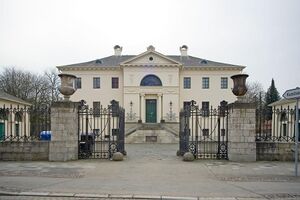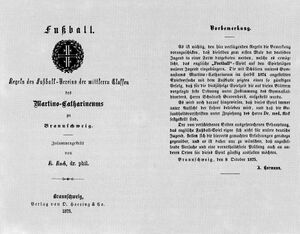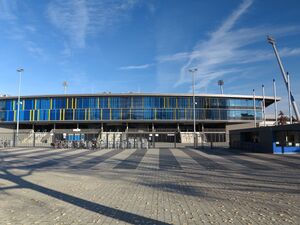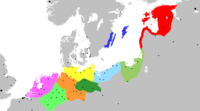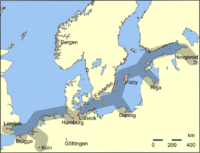براونشڤايگ
Brunswick
Braunschweig | |
|---|---|
Clockwise from top: Castle Square with Brunswick Cathedral, Dankwarderode Castle and the Brunswick Lion, Happy Rizzi House, Town Hall, Brunswick Palace, Old Town market with the Church of Saint Martin and the Alte Waage with the Church of Saint Andrew | |
أظهر موقع Brunswick within Lower Saxony | |
| الإحداثيات: 52°16′N 10°31′E / 52.267°N 10.517°E | |
| البلد | ألمانيا |
| الولاية | ساكسونيا السفلى |
| District | Urban district |
| تأسس | 9th century |
| التقسيمات | 19 boroughs |
| الحكومة | |
| • Lord mayor | Thorsten Kornblum[1] (SPD) |
| المساحة | |
| • City | 192٫13 كم² (74٫18 ميل²) |
| المنسوب | 75 m (246 ft) |
| التعداد | |
| • العمرانية | 1٬150٬000[2] |
| منطقة التوقيت | CET/CEST (UTC+1/+2) |
| Postal codes | 38100–38126 |
| Dialling codes | 0531, 05307, 05309, 05300 |
| لوحة السيارة | BS |
| الموقع الإلكتروني | Braunschweig.de |
براونشڤايك (بالألمانية: Braunschweig؛ النطق الألماني: [ˈbʁaʊ̯nʃvaɪ̯k]; Low German: Brunswiek [ˈbrɔˑnsviːk]; إنگليزية: Brunswick[3]), is a city of 250,556 people,[4]) هي ثاني أكبر مدينة في ولاية ساكسونيا السفلى في ألمانيا, عدد سكانها حوالي 240.000 نسمة.
من أشهر معالمها جامعة براونشڤايگ التقنية والتي تعتبر من أقدم الجامعات التقنية في أوروبا. موقعها 52° 16'خط عرض و 10° 31' خط طول.
تمتاز بموقعها الاستراتيجي في وسط شمال ألمانيا, ووقوعها بين مدن مهمة مثل برلين وهامبورگ وهانوڤر وگوتنگن.
التاريخ
Foundation and early history
The date and circumstances of the town's foundation are unknown. Tradition maintains that Brunswick was created through the merger of two settlements, one founded by Brun(o), a Saxon count who died in 880, on one side of the River Oker – the legend gives the year 861 for the foundation – and the other the settlement of a legendary Count Dankward, after whom Dankwarderode Castle (the "Castle of Dankward's clearing"), which was reconstructed in the 19th century, is named.[5][6]
The town's original name of Brunswik may be a combination of the name Bruno and Low German wik (related to the Latin vicus), a place where merchants rested and stored their goods. The town's name, therefore, may indicate a resting place, consistent with its location by a ford across the Oker River. An alternative explanation of the city's name is that it comes from Brand, or burning, indicating a place which developed after the landscape was cleared through burning.[7] The city was first mentioned in documents from the St. Magni Church from 1031, which give the city's name as Brunesguik.[6]
العصور الوسطى ومطلع العصر الحديث

Up to the 12th century, Brunswick was ruled by the Saxon noble family of the Brunonids; then, through marriage, the town fell to the House of Welf. In 1142, Henry the Lion of the House of Welf became duke of Saxony and made Braunschweig the capital of his state (which, from 1156 on, also included the Duchy of Bavaria). He turned Dankwarderode Castle, the residence of the counts of Brunswick, into his own Pfalz and developed the city further to represent his authority. Under Henry's rule, the Cathedral of St. Blasius was built and he also had the statue of a lion, his heraldic animal, erected in front of the castle. The lion subsequently became the city's landmark.[بحاجة لمصدر]
Henry the Lion became so powerful that he dared to refuse military aid to the Emperor Frederick I Barbarossa, which led to his banishment in 1182. Henry went into exile in England. He had previously established ties to the English crown in 1168, through his marriage to King Henry II of England's daughter Matilda, sister of Richard the Lionheart.[8] However, Henry's son Otto, who regained influence and was eventually crowned Holy Roman Emperor, continued to foster the city's development.[بحاجة لمصدر]
During the Middle Ages, Brunswick was an important center of trade, one of the economic and political centers in Northern Europe and a member of the Hanseatic League from the 13th century to the middle of the 17th century.[9] By the year 1600, Brunswick was the seventh largest city in Germany.[10] Although formally one of the residences of the rulers of the Duchy of Brunswick-Lüneburg, a constituent state of the Holy Roman Empire, Brunswick was de facto ruled independently by a powerful class of patricians and the guilds throughout much of the Late Middle Ages and the Early modern period. Because of the growing power of Brunswick's burghers, the Princes of Brunswick-Wolfenbüttel, who ruled over one of the subdivisions of Brunswick-Lüneburg, finally moved their Residenz out of the city and to the nearby town of Wolfenbüttel in 1432.[11] The Princes of Brunswick-Wolfenbüttel did not regain control over the city until the late 17th century, when Rudolph Augustus, Duke of Brunswick-Lüneburg, took the city by siege.[12]
In the 18th century Brunswick was not only a political, but also a cultural centre. Influenced by the philosophy of the Enlightenment, dukes like Anthony Ulrich and Charles I became patrons of the arts and sciences. In 1745, Charles I founded the Collegium Carolinum, predecessor of the Brunswick University of Technology, and in 1753 he moved the ducal residence back to Brunswick. With this he attracted poets and thinkers such as Lessing, Leisewitz, and Jakob Mauvillon to his court and the city.[13] Emilia Galotti by Lessing and Goethe's Faust were performed for the first time in Brunswick.[14]
19th century

In 1806, the city was captured by the French during the Napoleonic Wars and became part of the short-lived Napoleonic Kingdom of Westphalia in 1807. The exiled Duke Frederick William raised a volunteer corps, the Black Brunswickers, who fought the French in several battles.[15]
After the Congress of Vienna in 1815, Brunswick was made capital of the re-established independent Duchy of Brunswick, later a constituent state of the German Empire from 1871. In the aftermath of the July Revolution in 1830, in Brunswick duke Charles II was forced to abdicate. His absolutist governing style had previously alienated the nobility and bourgeoisie, while the lower classes were disaffected by the bad economic situation. During the night of 7–8 September 1830, the ducal palace in Brunswick was stormed by an angry mob, set on fire, and destroyed completely.[16] Charles was succeeded by his brother William VIII. During William's reign, liberal reforms were made and Brunswick's parliament was strengthened.[17]
During the 19th century, industrialisation caused a rapid growth of population in the city, eventually causing Brunswick to be for the first time significantly enlarged beyond its medieval fortifications and the River Oker.[18] On 1 December 1838, the first section of the Brunswick–Bad Harzburg railway line connecting Brunswick and Wolfenbüttel opened as the first railway line in Northern Germany, operated by the Duchy of Brunswick State Railway.[19][20]
Early to mid-20th century
On 8 November 1918, at the end of World War I, a socialist workers' council forced Duke Ernest Augustus to abdicate.[21][22] On 10 November, the council proclaimed the Socialist Republic of Brunswick under one-party government by the Independent Social Democratic Party of Germany (USPD); however, the subsequent Landtag election on 22 December 1918 was won by the Majority Social Democratic Party of Germany (MSPD), and the USPD and MSPD formed a coalition government.[23] An uprising in Braunschweig in 1919, led by the communist Spartacus League, was defeated when Freikorps troops under Georg Ludwig Rudolf Maercker took over the city on order of the German Minister of Defence, Gustav Noske.[24][25] An MSPD-led government was subsequently established; in December 1921, a new constitution was approved for the Free State of Brunswick, now a parliamentary republic within the Weimar Republic, again with Braunschweig as its capital.[26]
After the Landtag election of 1930, Brunswick became the second state in Germany where the Nazis participated in government, when the National Socialist German Workers' Party (NSDAP) formed a coalition government with several conservative and right-wing parties.[27] With the support of Dietrich Klagges, Brunswick's minister of the interior, the NSDAP organized a large SA rally in Braunschweig. On 17–18 October 1931, 100,000 SA stormtroopers marched through the city; street fights between Nazis, socialists, and communists left several dead or injured.[28] On 25 February 1932, the state of Brunswick granted Adolf Hitler German citizenship to allow him to run in the 1932 German presidential election.[29] In Braunschweig, Nazis carried out several attacks on political enemies, with the acquiescence of the state government.[30]
After the Nazi seizure of power in 1933, several state institutions were placed in Braunschweig, including the Luftfahrtforschungsanstalt in Völkenrode, the Hitler Youth Academy for Youth Leadership,[31] and the SS-Junkerschule Braunschweig.[32] With the Reichswerke Hermann Göring in Salzgitter and the Stadt des KdF-Wagens, as well as several factories in the city itself (including Büssing and the Volkswagenwerk Braunschweig), the Braunschweig region became one of the centres of the German arms industry.[33]
During the Second World War, Braunschweig was a sub-area headquarters of Wehrkreis XI (one of Germany's military districts),[34] and was the garrison city of the 31st Infantry Division that took part in the invasions of Poland, Belgium, and France, largely being destroyed during its retreat following the invasion of Russia.[بحاجة لمصدر] In this period, thousands of Eastern workers were brought to the city as forced labor,[35] and in the 1943–1945 period at least 360 children taken away from such workers died in the Entbindungsheim für Ostarbeiterinnen ("Maternity Ward for Eastern Workers").[36]
In 1944, two subcamps of the Neuengamme concentration camp were established in Braunschweig. The subcamp Schillstraße or Büssing-NAG/Schillstraße, located where the BraWo Park's parking lot is today, held about 800 male prisoners, who were forced to work in the arms production at Büssing-NAG. After about 300 had died due to disease, hunger, and maltreatment over the course of just a few months, a further 200 were transferred to the infirmary of a nearby subcamp in early January 1945 in order to reduce the number of deaths. However, this was only effective to some degree, as another 80 bodies landed in the city's crematory until the subcamp's closing in March 1945, when Büssing-NAG had to halt production due to severe bombing damages.[37][38][39] Today the Gedenkstätte Schillstraße, located very close to the former premises of the subcamp, documents Braunschweig's history during the Third Reich.[39][40] Büssing-NAG also had another subcamp in the nearby Vechelde, which held a further 400 male prisoners.[41][42]
The subcamp SS-Reitschule, named so as it was located on the former premises of the SS-Junker School's riding school, held approximately 800 prisoners, all female, who were tasked with clearing away rubble. This subcamp was commissioned by the city of Braunschweig. Although it was only open for two months - from December 1944 until February 1945, there were at least 17 deaths and a transfer of about 50 prisoners to a nearby subcamp's infirmary. The number of survivors is unknown.[43][44]
Piera Sonnino (1922–1999), an Italian author, writes of her imprisonment in Braunschweig in her book, This Has Happened, published in English in 2006 by MacMillan Palgrave.[بحاجة لمصدر]
The Allied air raid on October 15, 1944, destroyed most of the city's churches, and the Altstadt (old town), the largest homogeneous ensemble of half-timbered houses in Germany.[45] 100 out of 800 half-timbered houses survived as well as the most important places and streets, preserved in 5 areas of the old town.[46][47]
The city's cathedral, which had been converted to a Nationale Weihestätte (national shrine) by the Nazi government, still stood.[48]
Postwar period to the 21st century
About 10% of the inner city survived Allied bombing and remain to represent its distinctive architecture.[49] The cathedral was restored to its function as a Protestant church.[50] Outside the old town city centre large historic quarters remain like Östliches Ringgebiet with its Gründerzeit architecture.
Politically, after the war, the Free State of Brunswick was dissolved by the Allied occupying authorities, Braunschweig ceased to be a capital, and most of its lands were incorporated in the newly formed state of Lower Saxony.[51]
During the Cold War, Braunschweig, then part of West Germany, suffered economically due to its proximity to the Iron Curtain. The city lost its historically strong economic ties to what was then East Germany; for decades, economic growth remained, on average, below the rest of the country while unemployment was above-average for West Germany.[52]
On 28 February 1974, as part of a district reform in Lower Saxony, the rural district of Braunschweig, which had surrounded the city, was disestablished. The major part of the former district was incorporated into the city of Braunschweig, increasing its population by roughly 52,000 people.[53]
In the 1990s, efforts increased to reconstruct historic buildings that had been destroyed in the air raid.[بحاجة لمصدر] The façade of the Braunschweiger Schloss was rebuilt, and buildings such as the Alte Waage (originally built in 1534) now stand again.[54][55]
الديمغرافيا
| Year | Pop. | ±% |
|---|---|---|
| 1330 | 16٬000 | — |
| 1758 | 22٬500 | +40.6% |
| 1788 | 26٬000 | +15.6% |
| 1811 | 27٬600 | +6.2% |
| 1830 | 35٬300 | +27.9% |
| 1849 | 39٬000 | +10.5% |
| 1880 | 75٬000 | +92.3% |
| 1890 | 100٬000 | +33.3% |
| 1900 | 128٬200 | +28.2% |
| 1925 | 146٬900 | +14.6% |
| 1939 | 196٬068 | +33.5% |
| 1951 | 231٬091 | +17.9% |
| 1956 | 240٬431 | +4.0% |
| 1961 | 246٬085 | +2.4% |
| 1966 | 234٬665 | −4.6% |
| 1971 | 222٬805 | −5.1% |
| 1976 | 268٬519 | +20.5% |
| 1981 | 260٬342 | −3.0% |
| 1986 | 247٬836 | −4.8% |
| 1990 | 258٬833 | +4.4% |
| 2001 | 245٬516 | −5.1% |
| 2011 | 242٬537 | −1.2% |
| 2021 | 252٬816 | +4.2% |
| Population size may be affected by changes in administrative divisions. | ||
Braunschweig has a population of 250,000 and is the 2nd largest city in Lower Saxony. Braunschweig is considered as one of the oldest cities in Germany, founded in 1031 by Henry the Lion. Braunschweig first reached its peak of over 100,000 in 1890. In the 1960s and 1970s industrialization boomed in Braunschweig due to automobile and other companies coming to Braunschweig and surrounding cities like Wolfsburg and Salzgitter. Braunschweig's population reached its highest peak of population in 1975 with population of about 273,000. Braunschweig's population started to decline in the 1980s. In the 1990s - after the German reunification - it began to grow again as many East Germans moved there due to its close close proximity to former East Germany. Currently, Braunschweig has a strong focus on research and development. According to 2019 data, it has the highest R&D intensity (ratio of R&D expenditure to GDP) in the entire EU and over 4% of all employed people are R&D personnel.[56]
Religion
In 2015, 91,785 people (or 36.3% of the population) were Protestant and 34,604 (13.7%) people were Roman Catholic; 126,379 people (50.0%) either adhered to other denominations or followed no religion.[57]
Islam
Roughly 17,000 Muslims (6.2% of the population) live in Braunschweig. Mosques like DMK Moschee, Fatih Moschee Braunschweig and cultural clubs are present throughout the city but mosque buildings with minerates have not been built in Braunschweig but can be seen in its urban area for example the Grüne Moschee in Wolfenbüttel, Fatih Moschee Salzgitter and the Albanischer-Kulturverein in Gifhorn.
Immigration
A total of 84,994 of Braunschweig's residents, including citizens with second passport, had a migration background in 2023 (31.2% of the total population). Weststadt has the highest migration percentage being 63%. Majority of the ethnic groups come from Asia, Africa and Eastern European nations.[57] Among those, 39,785 were non-German citizens (15%);[57] the following table lists up the largest minority groups, including citizens with a migration background from a specific nation or region:
| Rank | Nationality | Population (2024-03-31) |
|---|---|---|
| 13,303 | ||
| 10,665 | ||
| 8,278 | ||
| 6,092 | ||
| 5,770 | ||
| 4,235 | ||
| 3,630 | ||
| 3,462 | ||
| 3,100 | ||
| 3,087 | ||
| 2,233 | ||
| 2,136 | ||
| 2,073 | ||
| 2,028 | ||
| 1,502 | ||
| 1,382 | ||
| 1,307 | ||
| 1,278 | ||
| 1,226 | ||
| 1,207 | ||
| 1,100 | ||
| 1,003 | ||
| 871 | ||
| 786 | ||
| 776 | ||
| 723 |
The estimated migration population in 2025 is 95,961 (35% of 274,233).
Urban area
The urban agglomeration area of Braunschweig is approximately 400,000 in 2024, making it one of the largest regiopolis after Mannheim and Bonn in Germany and the largest one in Lower Saxony. This area includes Wolfenbüttel, Meine, Salzgitter-Thiede, Salzgitter-Lebenstedt, Weddel, Sickte, Timmerlah, Lengede and other towns and regions within a 15 kilometer radius. Braunschweig's urban area makes it a bigger city compared to others with a similar size e.g. Aachen, Wiesbaden or Gelsenkirchen, and since the urban area is not significantly smaller than Hanover, it makes itself an important and major city in Lower Saxony. Companies like New Yorker, Salzgitter AG, Jägermeister, Siemens, Bosch, Volkswagen, Nordzucker, Continental, Kosatec and others are headquartered or have a branch in this area.
Information about the Urban Agglomeration in 2024:
Population: 401,234
Area size: 585.16
Population Density: 690 people per square kilometer
Migration background percentage: 46.4%
Largest cities, districts and towns: Braunschweig, Salzgitter, Kreis Wolfenbüttel, Lehrte, Kreis Cremlingen, Kreis Gifhorn, Vechelde, Lengede
The population of the urban area with a migration background is 186,302 in 2023, making it 46.4% of the population.[58] [59][60][61] This makes the agglomeration one of the most diverse in Germany and the most in Lower Saxony. The city is unique because unlike most cities with migrant populations concentrated inside the city itself, higher number of migrant populations are also found in surrounding areas. Braunschweig's urban agglomeration has a higher migration percentage compared to its city due to industrialization and other major factors since 2011.
One of the largest Vietnamese, Cameroonian and Tunisian populations in Germany are located in the surroundings and within Braunschweig.
These are the biggest nationalities in the urban area (these include the citizens with a migration background and a second passport):
| Rank | Countries predominant in the urban area | Population (2024-03-31) |
|---|---|---|
| 214,932 | ||
| 20,578 | ||
| 18,439 | ||
| 16,783 | ||
| 13,045 | ||
| 9,346 | ||
| 7,210 | ||
| 6,543 | ||
| 6,423 | ||
| 6,322 | ||
| 5,741 | ||
| 5,238 | ||
| 4,565 | ||
| 4,389 | ||
| 4,212 | ||
| 4,087 | ||
| 3,780 | ||
| 3,678 | ||
| 3,430 | ||
| 3,234 | ||
| 3,200 | ||
| 2,760 |
المناخ
Braunschweig's climate is classified as oceanic (Köppen: Cfb; Trewartha: Dobk). The average annual temperature in Braunschweig is 9.9 °C (49.8 °F). The average annual rainfall is 614.8 mm (24.20 in) with July as the wettest month. The temperatures are highest on average in July, at around 18.7 °C (65.7 °F), and lowest in January, at around 1.8 °C (35.2 °F).
The Braunschweig weather station has recorded the following extreme values:[64]
- Highest Temperature 38.3 °C (100.9 °F) on 20 July 2022.
- Warmest Minimum 22.6 °C (72.7 °F) on 10 July 2010.
- Coldest Maximum −17.5 °C (0.5 °F) on 11 February 1929.
- Lowest Temperature −26.3 °C (−15.3 °F) on 11 February 1929.[65]
- Highest Daily Precipitation 79.9 mm (3.15 in) on 17 July 2002.
- Wettest Month 212.6 mm (8.37 in) in July 2002.
- Wettest Year 989.3 mm (38.95 in) in 2002.
- Driest Year 295.7 mm (11.64 in) in 1959.
- Earliest Snowfall: 4 October 1925.
- Latest Snowfall: 22 April 1929.
- Longest annual sunshine: 2,128.2 hours in 2018.
- Shortest annual sunshine: 1,270.4 hours in 1960.
| أخفClimate data for Braunschweig (1991–2020 normals, extremes 1891–present[أ]) | |||||||||||||
|---|---|---|---|---|---|---|---|---|---|---|---|---|---|
| Month | Jan | Feb | Mar | Apr | May | Jun | Jul | Aug | Sep | Oct | Nov | Dec | Year |
| Record high °C (°F) | 15.9 (60.6) |
19.4 (66.9) |
24.4 (75.9) |
29.8 (85.6) |
35.4 (95.7) |
35.8 (96.4) |
38.3 (100.9) |
38.2 (100.8) |
33.7 (92.7) |
27.6 (81.7) |
21.5 (70.7) |
17.6 (63.7) |
38.3 (100.9) |
| Mean maximum °C (°F) | 11.3 (52.3) |
12.7 (54.9) |
17.4 (63.3) |
22.7 (72.9) |
27.2 (81.0) |
30.1 (86.2) |
31.8 (89.2) |
32.3 (90.1) |
26.7 (80.1) |
21.3 (70.3) |
15.6 (60.1) |
11.9 (53.4) |
33.9 (93.0) |
| Mean daily maximum °C (°F) | 4.1 (39.4) |
5.2 (41.4) |
9.0 (48.2) |
14.5 (58.1) |
18.5 (65.3) |
21.6 (70.9) |
23.9 (75.0) |
23.7 (74.7) |
19.3 (66.7) |
13.8 (56.8) |
8.2 (46.8) |
4.9 (40.8) |
13.9 (57.0) |
| Daily mean °C (°F) | 1.8 (35.2) |
2.4 (36.3) |
5.2 (41.4) |
9.6 (49.3) |
13.5 (56.3) |
16.6 (61.9) |
18.7 (65.7) |
18.4 (65.1) |
14.5 (58.1) |
10.1 (50.2) |
5.7 (42.3) |
2.8 (37.0) |
9.9 (49.8) |
| Mean daily minimum °C (°F) | −0.7 (30.7) |
−0.5 (31.1) |
1.5 (34.7) |
4.6 (40.3) |
8.3 (46.9) |
11.4 (52.5) |
13.6 (56.5) |
13.5 (56.3) |
10.2 (50.4) |
6.6 (43.9) |
3.1 (37.6) |
0.4 (32.7) |
6.0 (42.8) |
| Mean minimum °C (°F) | −10.0 (14.0) |
−8.2 (17.2) |
−4.3 (24.3) |
−1.7 (28.9) |
2.3 (36.1) |
6.5 (43.7) |
9.2 (48.6) |
8.2 (46.8) |
4.4 (39.9) |
−0.2 (31.6) |
−3.3 (26.1) |
−7.4 (18.7) |
−12.2 (10.0) |
| Record low °C (°F) | −23.6 (−10.5) |
−26.3 (−15.3) |
−16.5 (2.3) |
−7.3 (18.9) |
−2.7 (27.1) |
1.3 (34.3) |
5.3 (41.5) |
4.6 (40.3) |
−0.1 (31.8) |
−6.9 (19.6) |
−18.3 (−0.9) |
−20.9 (−5.6) |
−26.3 (−15.3) |
| Average precipitation mm (inches) | 50.3 (1.98) |
35.2 (1.39) |
43.2 (1.70) |
38.8 (1.53) |
54.8 (2.16) |
54.2 (2.13) |
70.6 (2.78) |
66.6 (2.62) |
51.1 (2.01) |
53.6 (2.11) |
48.1 (1.89) |
48.4 (1.91) |
614.8 (24.20) |
| Average extreme snow depth cm (inches) | 4.6 (1.8) |
3.8 (1.5) |
1.9 (0.7) |
0 (0) |
0 (0) |
0 (0) |
0 (0) |
0 (0) |
0 (0) |
0 (0) |
0.6 (0.2) |
3.6 (1.4) |
7.3 (2.9) |
| Average precipitation days (≥ 0.1 mm) | 17.3 | 15.3 | 15.0 | 12.3 | 13.9 | 13.5 | 15.5 | 14.2 | 13.0 | 15.6 | 16.7 | 17.8 | 180.1 |
| Average snowy days (≥ 1.0 cm) | 6.0 | 5.3 | 1.9 | 0 | 0 | 0 | 0 | 0 | 0 | 0 | 0.8 | 4.3 | 19.2 |
| Average relative humidity (%) | 84.9 | 81.6 | 76.8 | 69.7 | 70.4 | 71.2 | 71.0 | 71.9 | 77.5 | 83.0 | 86.4 | 86.0 | 77.6 |
| Mean monthly sunshine hours | 52.4 | 74.1 | 123.4 | 186.3 | 222.6 | 229.2 | 225.0 | 212.5 | 159.1 | 112.5 | 54.1 | 41.5 | 1٬692٫6 |
| Source 1: NOAA[66] | |||||||||||||
| Source 2: DWD Open Data[65][64] | |||||||||||||
الثقافة
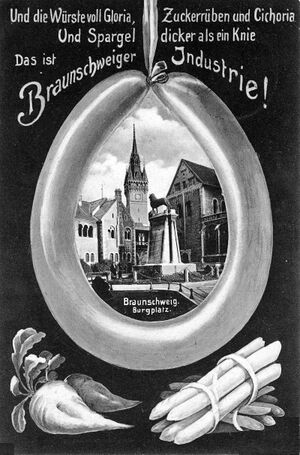
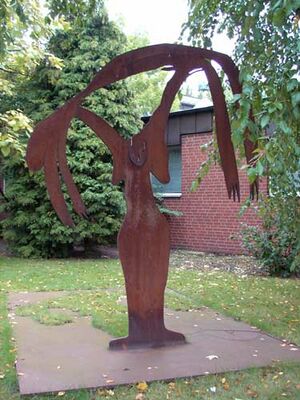
Braunschweig is famous for Till Eulenspiegel, a medieval jester who played many practical jokes on its citizens. It also had many breweries, and still a very peculiar kind of beer is made called Mumme, first quoted in 1390, a malt-extract that was shipped all over the world. Two major breweries still produce in Braunschweig, the Hofbrauhaus Wolters, founded in 1627, and the former Feldschlößchen brewery, founded in 1871, now operated by Oettinger Beer.
Braunschweiger Mettwurst, a soft, spreadable smoked pork sausage, is named after the city. Other traditional local dishes include white asparagus, Braunschweiger Lebkuchen, Braunkohl (a variant of kale served with Bregenwurst), and Uhlen un Apen (Low German for "Owls and Guenons", a pastry).[67][68]
Media
Braunschweig's major local newspaper is the Braunschweiger Zeitung, first published in 1946. Papers formerly published in Braunschweig include the Braunschweigische Anzeigen/Braunschweigische Staatszeitung (1745–1934), the Braunschweigische Landeszeitung (1880–1936) and the Braunschweiger Stadtanzeiger/Braunschweiger Allgemeiner Anzeiger (1886–1941), and the social-democratic Braunschweiger Volksfreund (1871–1933).
Near Braunschweig at Cremlingen-Abbenrode, there is a large medium wave transmitter, which transmits the program of Deutschlandfunk on 756 kHz, the Cremlingen transmitter.
Festivals
Schoduvel, a medieval Northern German form of carnival was celebrated in Braunschweig as early as the 13th century.[69] Since 1979 an annual Rosenmontag parade is held in Braunschweig, the largest in Northern Germany, which is named Schoduvel in honour of the medieval custom.[70]
An annual Weihnachtsmarkt (Christmas market) is held in late November and December on the Burgplatz in the centre of Braunschweig. In 2008 the market had 900,000 visitors.[71]
Museums and galleries
The city's most important museum is the Herzog Anton Ulrich Museum, a well known art museum and the oldest public museum in Germany, founded in 1754. It houses a collection of masters of Western art, including Dürer, Giorgione, Cranach, Holbein, Van Dyck, Vermeer, Rubens, and Rembrandt.
The State Museum of Brunswick (Braunschweigisches Landesmuseum), founded in 1891, houses a permanent collection documenting the history of the Brunswick area ranging from its early history to the present.
The Municipal Museum of Brunswick (Städtisches Museum Braunschweig), founded in 1861, is a museum for art and cultural history, documenting the history of the city of Braunschweig.
The State Natural History Museum is a zoology museum founded in 1754.
Other museums in the city include the Museum of Photography (Museum für Photographie), the Jewish Museum (Jüdisches Museum), the Museum for Agricultural Technology Gut Steinhof, and the Gerstäcker-Museum. Frequent exhibitions of contemporary art are also held by the Art Society of Braunschweig (German: Kunstverein Braunschweig), housed in the Villa Salve Hospes, a classicist villa built between 1805 and 1808.
Music and dance
The Braunschweig Classix Festival was an annual classical music festival. It is the largest promoter of classical music in the region and one of the most prominent music festivals in Lower Saxony.
From 2001 to 2009, and again since 2013, the annual finals of the international breakdance competition Battle of the Year have been held at the Volkswagen Halle in Braunschweig.[72]
Braunschweiger TSC is among the leading competitive formation dance teams in the world and has won multiple World and European championship titles.[73]
Sports
Braunschweig's major local football team is Eintracht Braunschweig. Founded in 1895, Eintracht Braunschweig can look back on a long and chequered history. Eintracht Braunschweig won the German football championship in 1967, and currently plays in the 2. Bundesliga, the second tier of German football, and attracts a large number of supporters. Braunschweig was also arguably the city in which the first ever game of football in Germany took place. The game had been brought to Germany by the local school teacher Konrad Koch, also the first to write down a German version of the rules of football,[nb 1] who organized the first match between pupils from his school Martino-Katharineum in 1874.[74] The 2011 German drama film Lessons of a Dream is based on Koch.
Eintracht Braunschweig also fields a successful women's field hockey team that claimed nine national championship titles between 1965 and 1978. In the past, the club also had first or second-tier teams in the sports of ice hockey, field handball, and water polo.
The New Yorker Lions (formerly Braunschweig Lions) are the city's American football team, winning a record number of 12 German Bowl titles, as well as five Eurobowls (a shared record).
The city's professional basketball team, the Basketball Löwen Braunschweig, plays in the Basketball Bundesliga, the highest level in Germany. The Löwen's predecessor SG Braunschweig had previously played in the Bundesliga as well. Eintracht Braunschweig's women's basketball team plays in the 2. Damen-Basketball-Bundesliga, the second tier of women's basketball in Germany.
In handball, MTV Braunschweig, the city's oldest sports club (founded in 1847), plays in the semi-professional 3. Liga.
Other sports clubs from Braunschweig that play or have played at the Bundesliga or 2nd Bundesliga level include Spot Up 89ers (baseball), Braunschweiger THC (field hockey), SV Süd Braunschweig (handball), Rugby-Welfen Braunschweig (rugby union), and USC Braunschweig (volleyball).
Annual sporting events held in Braunschweig include the international equestrian tournament Löwen Classics, Rund um den Elm, Germany's oldest road bicycle race,[75] and the professional tennis tournament Sparkassen Open.
المعالم
Twin towns – sister cities
Braunschweig is twinned with:[76]
ملاحظات
- ^ However, Koch's original German version of the rules of football, published in 1875, still resembled Rugby football—the unmodified rules of The Football Association were not commonly used in Germany before the 1900s.
انظر أيضاً
ملاحظات
الهامش
- ^ "Stichwahlen zu Direktwahlen in Niedersachsen vom 26. September 2021" (PDF). Landesamt für Statistik Niedersachsen. 13 October 2021. Archived from the original (PDF) on 16 November 2021. Retrieved 16 November 2021.
- ^ "Regionales Energiekonzept für den Großraum Braunschweig" (PDF). Zgb.de. Retrieved August 16, 2012.
- ^ "Brunswick" (definition 2), The American Heritage Dictionary p. 245 3d. ed. 1992
- ^ "Bevölkerungsfortschreibung" (in German). Landesbetrieb für Statistik und Kommunikationstechnologie Niedersachsen. December 31, 2011. Accessed August 5, 2012.
- ^ H. Mack (1925): "Überblick über die Geschichte der Stadt Braunschweig", in: F. Fuhse (ed.), Vaterländische Geschichten und Denkwürdigkeiten der Lande Braunschweig und Hannover, Band 1: Braunschweig, 3rd edition, Braunschweig: Appelhans Verlag, p. 34.
- ^ أ ب "Die Ersterwähnung von 'Brunesguik' und die Gründungssage". Braunschweig.de. Archived from the original on 2013-05-07. Retrieved 2015-07-12.
- ^ Moderhack, Richard (1997). Braunschweiger Stadtgeschichte (in الألمانية). Braunschweig: Wagner. pp. 14–15 and 21. ISBN 3-87884-050-0.
- ^ "The Lion City of Brunswick (Braunschweig)". Germany.travel. Archived from the original on 2015-09-24. Retrieved 2015-07-12.
- ^ Moderhack 1997, pp. 50–52
- ^ Camerer; Garzmann; Pingel; Schuegraf (1996). Braunschweiger Stadtlexikon (in الألمانية) (4th ed.). p. 66.
- ^ Moderhack 1997, pp. 60–69
- ^ Moderhack 1997, pp. 119–123
- ^ Moderhack 1997, pp. 136–141
- ^ Camerer et al. 1996, p. 215
- ^ Horst-Rüdiger Jarck; Günter Scheel, eds. (1996). Braunschweigisches Biographisches Lexikon – 19. und 20. Jahrhundert (in الألمانية). Hannover: Hahnsche Buchhandlung. p. 92. ISBN 3-7752-5838-8.
- ^ Schildt, Gerhard (2000). "Von der Restauration zur Reichsgründungszeit". In Horst-Rüdiger Jarck; Gerhard Schildt (eds.). Die Braunschweigische Landesgeschichte. Jahrtausendrückblick einer Region. Braunschweig: Appelhans Verlag. pp. 753–766. ISBN 3-930292-28-9.
- ^ Schildt 2000, pp. 772–777
- ^ "Geschichte". Braunschweig.de. Retrieved 2015-07-19.
- ^ E. Oppermann (1911): Landeskunde des Herzogtums Braunschweig. Geschichte und Geographie. Braunschweig: E. Appelhans, p. 64.
- ^ Neubauer, Jürgen / Salewsky, Dieter (1988): 150 Jahre 1. Deutsche Staatseisenbahn Braunschweig-Wolfenbüttel. Braunschweig: Joh. Heinr. Meyer Verlag. ISBN 3-926701-05-6.
- ^ Moderhack 1997, pp. 193–194
- ^ Rother, Bernd (1990). Die Sozialdemokratie im Land Braunschweig 1918 bis 1933 (in الألمانية). Bonn: Verlag J. H. W. Dietz Nachf. pp. 27–30. ISBN 3-8012-4016-9.
- ^ Rother 1990, pp. 36–37 and 288
- ^ Rother 1990, pp. 67–72
- ^ Hans-Ulrich Ludewig (2000): Der Erste Weltkrieg und die Revolution (1914–1918/19), in: Horst-Rüdiger Jarck / Gerhard Schildt (eds.), Die Braunschweigische Landesgeschichte. Jahrtausendrückblick einer Region, Braunschweig: Appelhans Verlag, pp. 935–943. ISBN 3-930292-28-9.
- ^ Moderhack 1997, pp. 194–195
- ^ Rother 1990, p. 234
- ^ Rother 1990, p. 244
- ^ Rother 1990, p. 247
- ^ Rother 1990, pp. 247–248
- ^ "Akademie für Jugendführung". Vernetztes-gedaechtnis.de. Retrieved 2015-07-24.
- ^ "Braunschweiger Schloss / SS-Junkerschule". Vernetztes-gedaechtnis.de. Retrieved 2015-07-24.
- ^ Jörg Leuschner (2008): Die Wirtschaft des Braunschweigischen Landes im Dritten Reich (1933–1939), in: Jörg Leuschner / Karl Heinrich Kaufhold / Claudia Märtl (eds.), Die Wirtschafts- und Sozialgeschichte des Braunschweigischen Landes vom Mittelalter bis zur Gegenwart, vol. 3, Hildesheim: Georg Olms Verlag, pp. 468–522; ISBN 978-3-487-13599-1
- ^ Dieter Lent (2000): Kriegsgeschehen und Verluste im Zweiten Weltkrieg, in: Horst-Rüdiger Jarck / Gerhard Schildt (eds.), Die Braunschweigische Landesgeschichte. Jahrtausendrückblick einer Region, Braunschweig: Appelhans Verlag, pg. 1026; ISBN 3-930292-28-9
- ^ Fiedler, Gudrun; Ludewig, Hans-Ulrich, eds. (2003). Zwangsarbeit und Kriegswirtschaft im Lande Braunschweig 1939–1945 (in الألمانية). Braunschweig: Appelhans Verlag. ISBN 3-930292-78-5.
- ^ "Entbindungsheim für Ostarbeiterinnen". Vernetztes-gedaechtnis.de. Retrieved 2015-07-12.
- ^ "Braunschweig (Büssing-NAG)". KZ-Gedenkstätte Neuengamme. Retrieved 2024-08-31.
- ^ "Die Geschichte des KZ-Außenlagers an der Schillstraße". www.vernetztes-gedaechtnis.de. Retrieved 2024-09-01.
- ^ أ ب "Gedenkstätte Schilstrasse". www.vernetztes-gedaechtnis.de. Retrieved 2024-09-01.
- ^ "Aufgabe / Gedenkstätte Schillstraße · Braunschweig". www.schillstrasse.de. Retrieved 2024-09-01.
- ^ "Vechelde". KZ-Gedenkstätte Neuengamme. Retrieved 2024-08-31.
- ^ "Historischer Ort / Gedenkstätte Schillstraße · Braunschweig". www.schillstrasse.de. Retrieved 2024-09-01.
- ^ "Braunschweig (SS-Reitschule)". KZ Gedenkstätte Neuengamme. Retrieved 2024-08-31.
- ^ "KZ-Außenlager SS-Reithalle". www.vernetztes-gedaechtnis.de. Retrieved 2024-09-01.
- ^ "Braunschweig: Steeped in History". Deutsche Welle. 2005-03-02. Retrieved 2015-07-17.
- ^ leopard.tu-braunschweig.de
- ^ tour100.blog
- ^ "Dom - Überblick". Vernetztes-gedaechtnis.de. Retrieved 2015-07-12.
- ^ "Braunschweig zwischen Tradition und Moderne". Norddeutscher Rundfunk. 2015-01-29. Retrieved 2015-07-17.
- ^ "Die wechselvolle Geschichte des Braunschweiger Doms". braunschweigerdom.de. Archived from the original on 2015-09-23. Retrieved 2015-07-17.
- ^ "Lower Saxony". Encyclopædia Britannica Online. Retrieved 2015-07-17.
- ^ Gudrun Fiedler / Norman-Mathias Pingel (2008): Vom Nachkriegsboom in den Strukturwandel. Die Wirtschaft der Landes-Region Braunschweig nach 1945, in: Jörg Leuschner / Karl Heinrich Kaufhold / Claudia Märtl (eds.), Die Wirtschafts- und Sozialgeschichte des Braunschweigischen Landes vom Mittelalter bis zur Gegenwart, vol. 3, Hildesheim: Georg Olms Verlag, pp. 586–588. ISBN 978-3-487-13599-1.
- ^ "Stadtchronik Braunschweig". Braunschweig.de. Archived from the original on 2013-09-27. Retrieved 2015-07-12.
- ^ "Die Geschichte des Braunschweiger Schlosses" (in الألمانية). braunschweig.de. Retrieved 2015-07-18.
- ^ Justus Herrenberger (1993): Die Baustelle "Alte Waage" in Braunschweig, in: Jahrbuch 1992 der Braunschweigischen Wissenschaftlichen Gesellschaft, Göttingen: Verlag Erich Goltze KG, pp. 29-36.
- ^ European Commission. Statistical Office of the European Union. (2023). Eurostat regional yearbook: 2023 edition (PDF). Luxembourg: (Publications Office of the) European Union. pp. 152, 158. doi:10.2785/606702. ISBN 978-92-68-05058-3. ISSN 2363-1716.
- ^ أ ب ت "Aktuelle Bevölkerungsdaten" (PDF). braunschweig.de. 2015-12-31. Archived from the original (PDF) on 2016-02-15. Retrieved 2016-02-29.
- ^ أ ب ت "Bevölkerung mit erweitertem Migrationshintergrund in Braunschweig am 31.12.2023" (PDF). braunschweig.de. 2024. Retrieved 2024-11-03.
- ^ أ ب ت "Braunschweig – Ein Zuhause für Menschen aus 170 Ländern". braunschweiger-zeitung.de. 2022-09-24. Retrieved 2024-11-03.
- ^ "Integration & Gesellschaft". lkwf.de (in الألمانية). Retrieved 2024-11-03.
- ^ "Bevölkerung nach Migrationsstatus 2018 nach Landkreisen und kreisfreien Städten" (xlsx) (in الألمانية). Retrieved 2024-11-03.
- ^ "Integration & Gesellschaft". lkwf.de (in الألمانية). Retrieved 2024-11-03.
- ^ "Bevölkerung nach Migrationsstatus 2018 nach Landkreisen und kreisfreien Städten" (xlsx) (in الألمانية). Retrieved 2024-11-03.
- ^ أ ب "Monatsauswertung". sklima.de (in الألمانية). SKlima. Retrieved 27 October 2024.
- ^ أ ب "Extremwertanalyse der DWD-Stationen, Tagesmaxima, Dekadenrekorde, usw" (in الألمانية). DWD. Retrieved 27 October 2024.
- ^ "Braunschweig Climate Normals 1991–2020". National Oceanic and Atmospheric Administration. Archived from the original on 16 September 2023. Retrieved 16 September 2023.
- ^ "Typisch köstlich" (in الألمانية). Retrieved 3 June 2016.
- ^ "Braunschweig - Kulinarische Spezialitäten vom Mittelalter bis heute" (in الألمانية). Archived from the original on 2016-06-29. Retrieved 3 June 2016.
- ^ Søndergaard, Leif. "Carnival is Festival: Dances as Entertainment". Retrieved 8 October 2012.
- ^ "Braunschweiger Karneval "Schoduvel"" (in الألمانية). Archived from the original on 31 August 2012. Retrieved 8 October 2012.
- ^ "900 000 Besucher auf dem Weihnachtsmarkt" (in الألمانية). 29 December 2008. Archived from the original on 30 May 2016. Retrieved 8 October 2012.
- ^ "About BOTY". Archived from the original on 25 September 2011. Retrieved 27 August 2012.
- ^ "List of World and European champions". Archived from the original on 23 August 2013. Retrieved 27 August 2012.
- ^ "Die Wiege des Fußballs stand in Braunschweig" (PDF) (in الألمانية). Archived from the original (PDF) on 7 December 2010. Retrieved 8 August 2012.
- ^ Hoffmeister, Kurt (2010). Zeitreise durch die Braunschweiger Sportgeschichte: 180 Jahre Turnen und Sport in Braunschweig (in الألمانية). p. 43.
- ^ "Braunschweigs Partner- und Freundschaftsstädte". braunschweig.de (in الألمانية). Braunschweig. Retrieved 2021-02-10.
- ^ "Braunschweig schließt Partnerschaft mit Gemeinde in Südafrika". regionalheute.de (in الألمانية). Retrieved 2024-11-14.
وصلات خارجية
قالب:Germany districts lower saxony
خطأ استشهاد: وسوم <ref> موجودة لمجموعة اسمها "lower-alpha"، ولكن لم يتم العثور على وسم <references group="lower-alpha"/>
- Pages using gadget WikiMiniAtlas
- CS1 الألمانية-language sources (de)
- Short description is different from Wikidata
- Coordinates on Wikidata
- Germany articles requiring maintenance
- Pages using infobox German location with unknown parameters
- Towns in Lower Saxony
- Articles containing إنگليزية-language text
- Pages using Lang-xx templates
- Articles with unsourced statements from July 2022
- Articles with unsourced statements from July 2015
- Pages with empty portal template
- عواصم أمم سابقة
- أعضاء الرابطة الهانزية
- مدن ألمانيا












